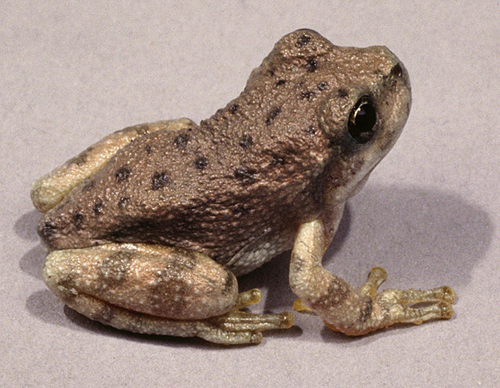canyon treefrog
Hyla arenicolorSummary 7
The canyon tree frog (Hyla arenicolor) is a species of tree frog native to the rocky plateau areas of southern United States, primarily in New Mexico and Arizona, but it also ranges to Utah, Texas, and Colorado, and as far south as the Mexican states of Michoacán, México, Guanajuato, Guerrero, and Oaxaca.
Description 8
Hyla arenicolor adult frogs range from 32-57 mm in SVL. It has rough warty skin which prevents desiccation. Webbing is well developed but does not extend to the hind leg's fifth toe. Toe pads are considerably enlarged. It is distinguished from similar species by having a dark-edged light spot beneath the eye, instead of a dark bar running through the eye. Dorsal coloration is brown to gray and randomly spotted, while ventral coloration is cream to orange-yellow. This coloration aids in its ability to camouflage. When exposed to sun, the dorsal coloration changes from being normally dark to a light gray. (Stebbins 2003).
Hyla arenicolor feeds on a variety of insects, including beetles, ants, and caterpillers (Behler 1979).
Albinos have been found only in this species of Hyla. In albino frogs, the eyes have red pupils with white irises (Van Devender 1969).
Range description 9
This species occurs from western and southeastern Colorado and southern Utah, south through Arizona and western New Mexico in the USA to northern Oaxaca in Mexico. There are also isolated populations in northeastern New Mexico and the Big Bend area of western Texas. It is found from near sea level to about 3,000m asl (Stebbins, 1985).
Iucn red list assessment 10
Red List Category
Red List Criteria
Version
Year Assessed
Assessor/s
Reviewer/s
Contributor/s
Justification
History
-
2004Least Concern
Fuentes y créditos
- (c) Kerry Matz, algunos derechos reservados (CC BY-NC-SA), http://www.flickr.com/photos/47456931@N07/4416938085
- (c) Katja Schulz, algunos derechos reservados (CC BY), http://farm3.static.flickr.com/2701/4428887672_5699785323.jpg
- (c) 2010 California Academy of Sciences, algunos derechos reservados (CC BY-NC-SA), http://calphotos.berkeley.edu/cgi/img_query?seq_num=315323&one=T
- (c) Katja Schulz, algunos derechos reservados (CC BY-NC), http://farm5.static.flickr.com/4042/4428121883_22b49db4aa.jpg
- (c) 2000 California Academy of Sciences, algunos derechos reservados (CC BY-NC-SA), http://calphotos.berkeley.edu/cgi/img_query?seq_num=24704&one=T
- (c) 2000 California Academy of Sciences, algunos derechos reservados (CC BY-NC-SA), http://calphotos.berkeley.edu/cgi/img_query?seq_num=24705&one=T
- (c) Wikipedia, algunos derechos reservados (CC BY-SA), http://en.wikipedia.org/wiki/Hyla_arenicolor
- (c) AmphibiaWeb © 2000-2011 The Regents of the University of California, algunos derechos reservados (CC BY), http://eol.org/data_objects/23852173
- (c) International Union for Conservation of Nature and Natural Resources, algunos derechos reservados (CC BY-NC-SA), http://eol.org/data_objects/28155353
- (c) International Union for Conservation of Nature and Natural Resources, algunos derechos reservados (CC BY-NC-SA), http://eol.org/data_objects/28155352











